Basement ceiling ideas are often overlooked, but they’re crucial for transforming a room. A well-designed ceiling can make a basement stylish and welcoming. You can choose bold paint or creative materials like tin tiles or Jerusalem stone to make a difference.
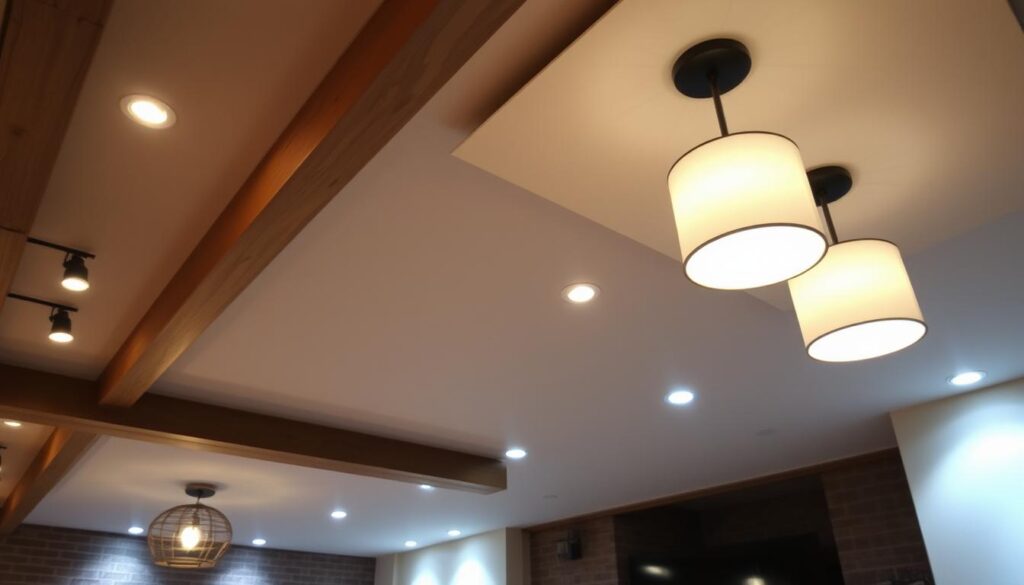
Stylish basement ceiling decor doesn’t have to be hard. Simple changes like olive green paint or high-gloss tiles can add warmth and light. For something dramatic, try a black ceiling for an art gallery look or vibrant colors for energy.
Explore how decorative beams, beadboard panels, or hanging lights can change your space. These 20 ideas blend affordability with creativity. From DIY projects to acoustic panels, let’s make your basement’s ceiling the highlight.
1. Understanding the Importance of Basement Ceilings
Basement ceiling ideas do more than hide ducts or wiring. They set the room’s mood. A smart ceiling can turn a basement into a useful and stylish spot. It affects light, sound, and coziness.
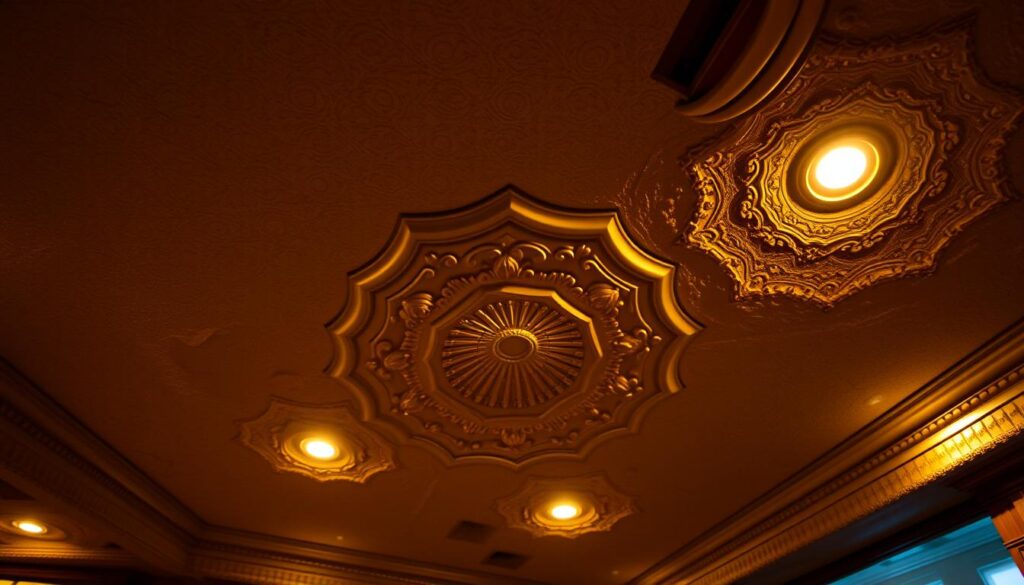
Why Ceiling Design Matters
Basements often have low ceilings or uneven floors. Design choices are key. Suspended ceilings hide pipes and make repairs easy. They also keep moisture out, which is vital in damp areas.
LED lights can make small spaces look bigger. Every choice impacts comfort and safety.
Functionality and Aesthetics
Function starts with being practical. Creative designs like tin tiles or wood planks add texture and last long. Black panels reduce sound, and coffered styles add visual appeal.
Mixing bold colors or patterns makes spaces seem larger. Even simple touches like painted lines or recessed lighting can make a basement modern.
2. Choosing the Right Ceiling Height
Basement ceiling height greatly affects the room’s feel. First, check your space’s limits. For low basement ceiling ideas, use tricks to make it seem taller. Light colors on walls and ceilings reflect light, making the space feel bigger.
Vertical stripes or paneling can also make the ceiling seem higher. Recessed lighting is a good choice because it’s low-profile yet brightens up corners.
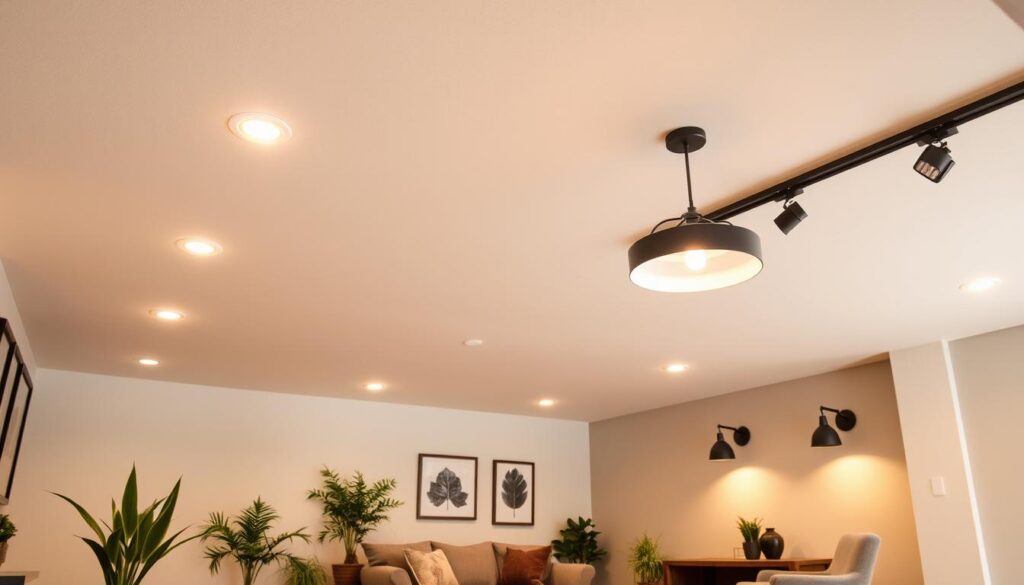
Low Ceilings: Design Tips
- Paint ceilings and walls white or pale neutrals to enhance brightness.
- Use vertical stripes or wood paneling to create the illusion of height.
- Install recessed lights or sconces to avoid bulky fixtures.
- Exposed wood joists with white paint add rustic charm without clutter.
High Ceilings: Maximize the Space
High ceilings offer a lot of possibilities. To balance them, use fixtures or details that are not too big. Here are some tips:
| Low Basement Ceiling Ideas | High Ceiling Solutions |
|---|---|
| Tray ceilings with recessed lighting | Pendant lighting clusters to define zones |
| Exposed ductwork in industrial designs | Wood beams for rustic farmhouse looks |
| Light-colored drywall for budget-friendly height | Asymmetrical tray ceilings for visual depth |
Match these basement ceiling ideas with furniture that’s low to the ground and vertical mirrors. This keeps the space balanced. Think about what you want the space to be—whether it’s a cozy spot or a big workshop.
3. Paint Options for Your Basement Ceiling
Paint is a great basement ceiling finish options that can change a space without costing much. You can pick a light color for an open feel or a dark one for a cozy spot. The right color and sheen can make your basement look new.
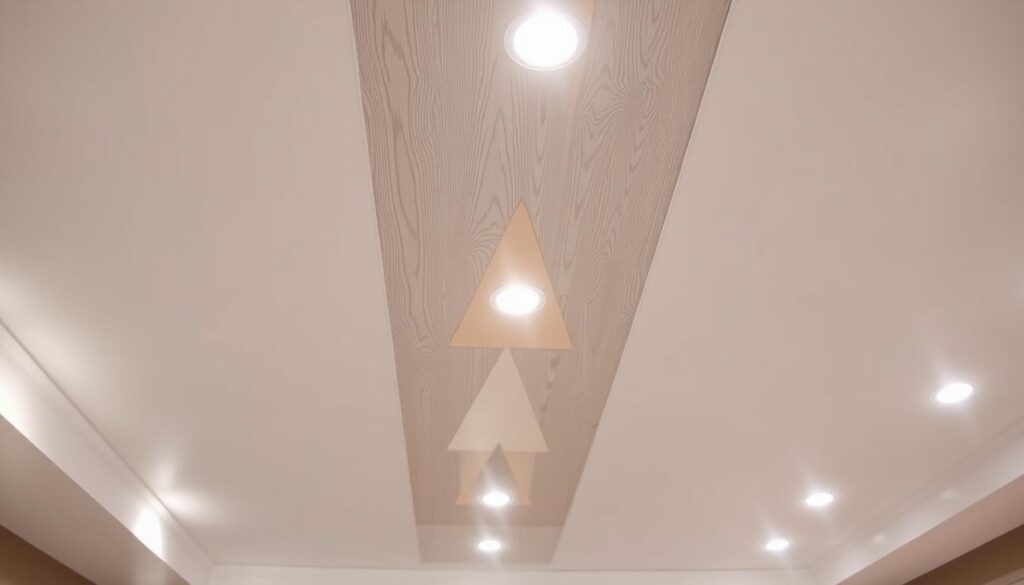
| Bright Colors | Dark Colors |
|---|---|
| White, Cream, Pale Blue | Olive Green, Urbane Bronze, Iron Ore |
| Reflects light for spaciousness | Creates intimate atmospheres |
| Good for family rooms or offices | Suits media rooms or dens |
Bright Colors for an Open Feel
Light shades like Sherwin Williams Emerald line in satin finish make small spaces look bigger. Pale blues or whites make vaulted ceilings seem taller. For a modern look, pair white with exposed ductwork for an industrial edge. Pro tip: Use spray application for even coverage.
Dark Colors for a Cozy Ambience
Deep hues like Sherwin Williams 2021 Urbane Bronze add drama. Olive green, featured in Emily Henderson’s designs, warms up lounges. Always apply a primer (four cans recommended) to ensure durability. Moisture-resistant formulas like Sherwin Williams Iron Ore resist humidity.
- Prime surfaces with four coats of primer for dark shades
- Opt for spray application to avoid brush marks
- Use satin or eggshell sheen for easy cleaning
4. Exposed Ceiling Beams: Industrial Style
Exposed ceiling beams make a big statement in basements, mixing function with an industrial look. They turn basements into open, lively spaces without the need for expensive changes. Interior designer Clara Martinez says, “Exposed beams turn hidden infrastructure into design focal points,” making them perfect for industrial-style projects.
“Embrace, don’t hide—structural elements define modern spaces.”
Benefits of Exposed Beams
- They make rooms feel bigger by showing off the ceiling height
- They add texture with raw wood or metallic finishes for a real industrial feel
- They save money by avoiding the need for drywall
Best Materials for Beams
For DIY basement ceiling projects, pick from real timber, steel, or faux beams. Pine or reclaimed wood brings warmth, while galvanized steel looks sleek. Mix wide wood planks (Idea #21) with metallic accents for a rustic-industrial look. Dark stains or paints (Idea #18) enhance the industrial feel.
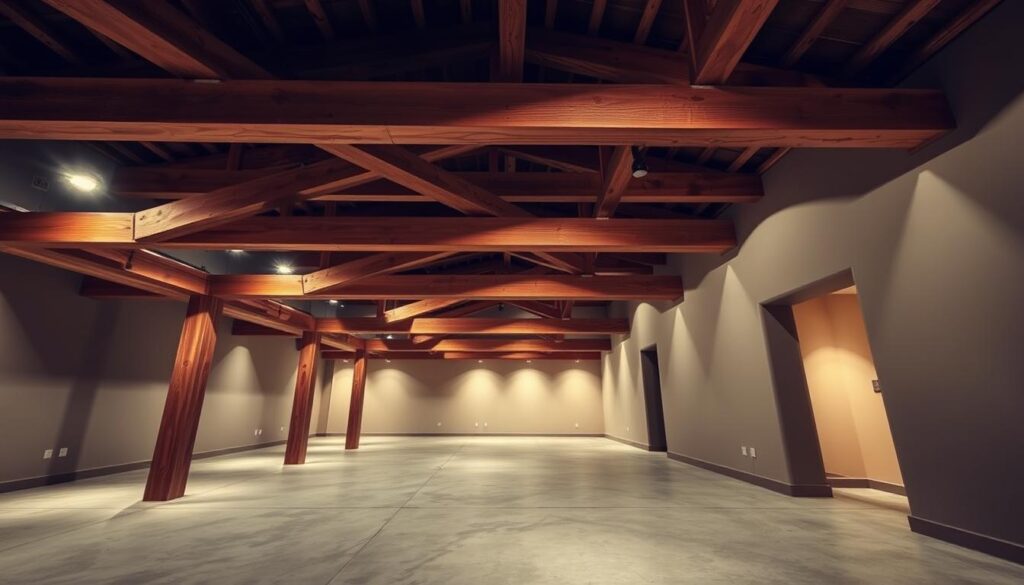
Ready to start? Faux beam kits make DIY projects easy, letting you achieve the look without changing the structure. Pair them with Idea #24’s light wood beams for a nice contrast. Remember to dust and seal them regularly to keep them looking great for years.
5. Drop Ceilings: Versatile Solutions
Drop ceilings are affordable basement ceiling options that are both functional and stylish. They are no longer seen as plain or outdated. Modern designs now mix practicality with beauty.
They are perfect for basements because they hide pipes and wires. Plus, they make it easy to access for maintenance. Adding lighting can really make them stand out.
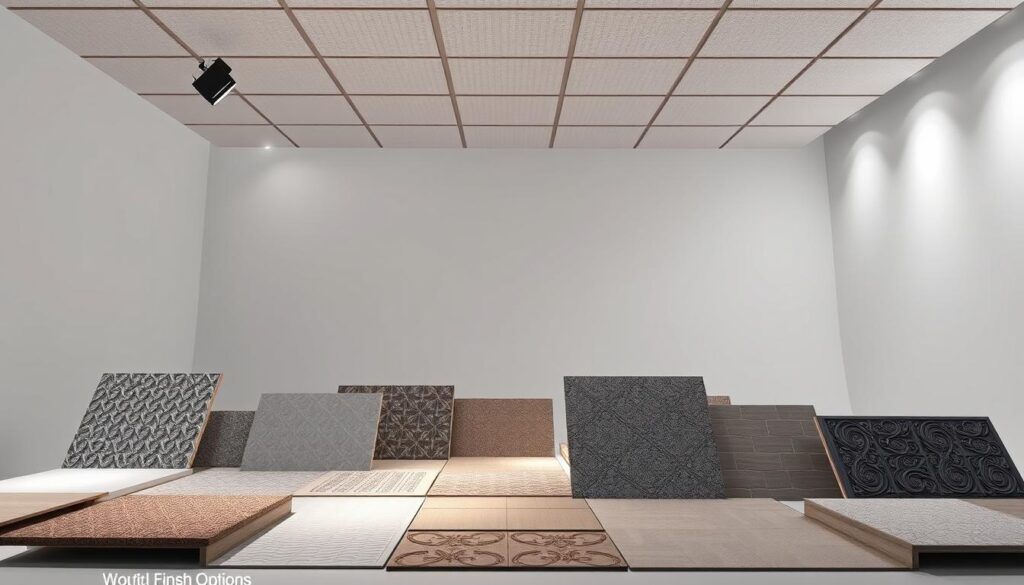
Installation Process
Installing drop ceilings begins with a metal grid system. Tiles are easy to snap into place, making it a DIY-friendly project. You’ll need tools like a utility knife and level.
Brands like USG Ceilings’ Radar tiles offer a classic grid pattern. This makes setup simple without losing style. Always follow the manufacturer’s guidelines for a secure fit.
Design Choices for Tiles
- Basement ceiling finish options include textured tiles, metallic finishes, or wood-look panels.
- A La Maison Ceilings’ Line Art tiles add geometric patterns for a modern touch.
- Acoustic tiles reduce echo, while moisture-resistant options prevent mold in humid basements.
Pairing them with recessed lights or pendant fixtures can really show off their design. They may lower headspace a bit, but their versatility makes them a great choice. They work well in both casual and polished basement spaces.
6. Wood Paneling: Warm and Inviting
Turn your basement into a cozy spot with wood paneling. It brings natural texture and warmth, great for adding a rustic or modern feel. Light wood planking makes spaces feel airy and welcoming. Darker stains, on the other hand, create a cozy atmosphere.
Pair wood paneling with modern lights for a balanced look. This mix of old and new is perfect for any basement.
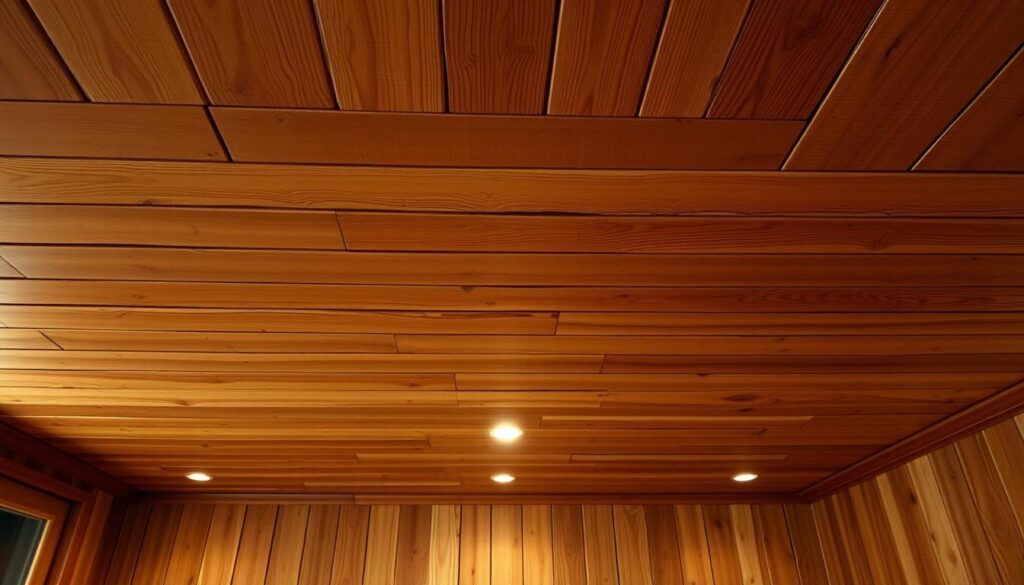
Types of Wood for Basements
- Cedar or pine: Naturally resistant to moisture and affordable.
- Engineered wood: Resists warping and holds up in humid environments.
- Salvaged wood: Adds historical charm and unique character.
Installation Tips
First, check for moisture and seal the walls. Use adhesive or nail-on systems for a simple DIY job. Thin planks work well on uneven surfaces.
Finish with sealants to protect against humidity. Mixing panel widths creates a textured look. Pro tip: Try this for a layered effect.
White wood panels brighten small areas. Bold stains or lacquered finishes add flair. Decorative moldings enhance architectural details. Wood paneling works well in game rooms or home offices, adding style to any basement.
7. Cork Ceilings: Eco-Friendly Choice
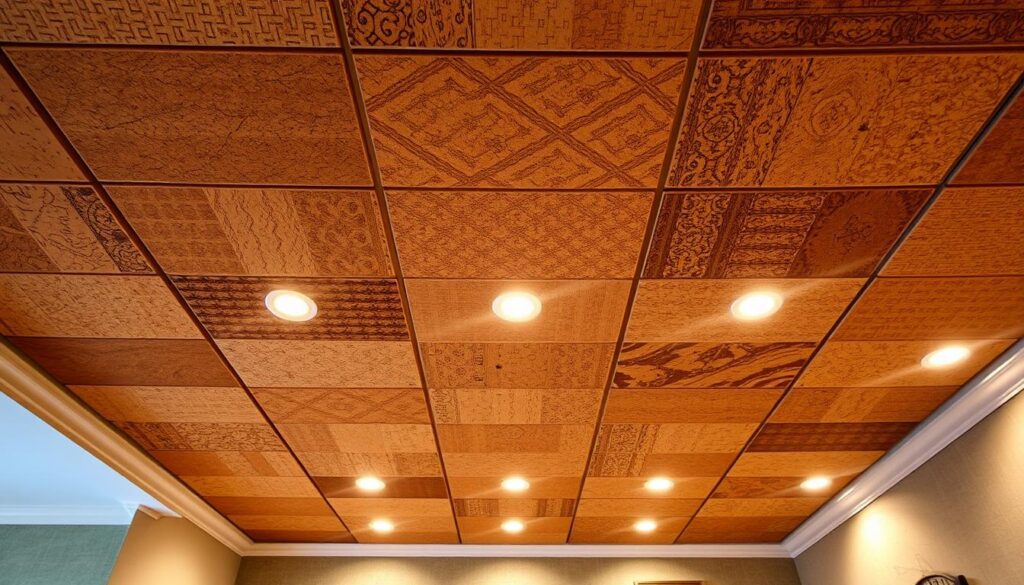
Make your basement special with cork ceilings. They mix green living with cool looks. Cork is a natural material that’s good for the planet and your space.
It’s great for soundproofing, keeping humidity in check, and fighting mold. CorkSribas highlights its ability to grow back, making it a top pick for modern basement ceiling solutions.
“Cork is nature’s own insulation, combining elegance with environmental care.” — CorkSribas Sustainability Report
Benefits of Cork
- Natural soundproofing reduces noise from upper floors
- Thermal insulation cuts energy costs
- Resists mold and mildew in damp basements
- Offers warm, organic textures for rustic or modern styles
- Meets LEED certification standards for green building
Installation Insights
First, get your surface ready. Use pre-cut tiles or panels for easy DIY. Or, hire pros for big jobs.
- Acclimate cork planks in the basement for 48 hours
- Use non-toxic adhesives compatible with basement conditions
- Seal edges with silicone to prevent moisture ingress
Costs are around $8–$12 per square foot. It’s a bit pricier than drywall but worth it in the long run. Cork’s texture fits many styles, showing eco-friendly doesn’t mean you have to sacrifice looks.
8. Tin Ceiling Tiles: Vintage Vibe
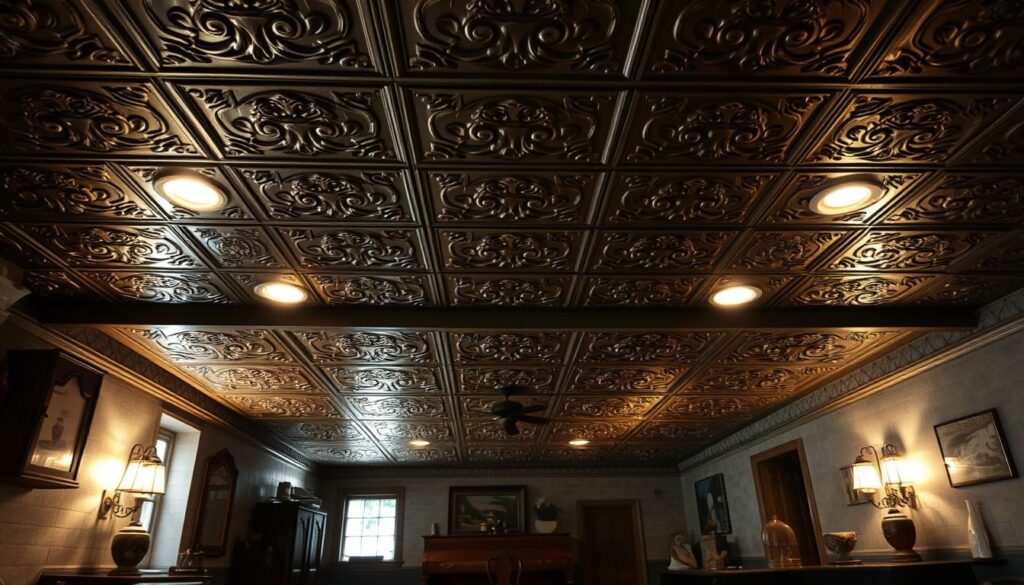
Tin ceiling tiles turn basements into spaces full of history and elegance. They bring stylish basement ceiling decor and creative basement ceiling designs that remind us of classic buildings. Brands like Armstrong’s Kanopi by MirroFlex offer faux tin options that are both affordable and authentic.
A local café used colored tin tiles to craft a vibrant collage, enhancing their rustic ambiance with minimal upkeep.
Selecting the Right Design
There are many patterns to choose from, like Victorian floral motifs and Art Deco lines. For smaller rooms, 12”x12” tiles are perfect. Larger rooms can use 24”x24” or 24”x48” tiles.
For a bold look, try 48”x96” PVC panels that mimic tin. TINCRAFT’s embossed finishes or TINTILE’s geometric circles add interest without being too much.
| Product | Features | Best Use |
|---|---|---|
| TINCRAFT | PVC, 12″x12″, waterproof | Rustic or modern basements |
| TINTILE | 3D embossed patterns, antique finishes | Victorian-themed spaces |
| MirroFlex | Glue-up panels, 4×8 ft sheets | Large-scale installations |
Maintenance Tips
- Wipe with mild soap to avoid scratches.
- Use rust-inhibitors in humid areas.
- Touch-up paints match original finishes.
Real tin tiles are authentic but need more care. PVC versions are better for basements because they resist moisture. Make sure they meet fire safety standards, like Armstrong’s Class A certification. Add recessed lighting to make the patterns stand out, creating a timeless look.
9. Adding Lighting Fixtures to Your Ceiling
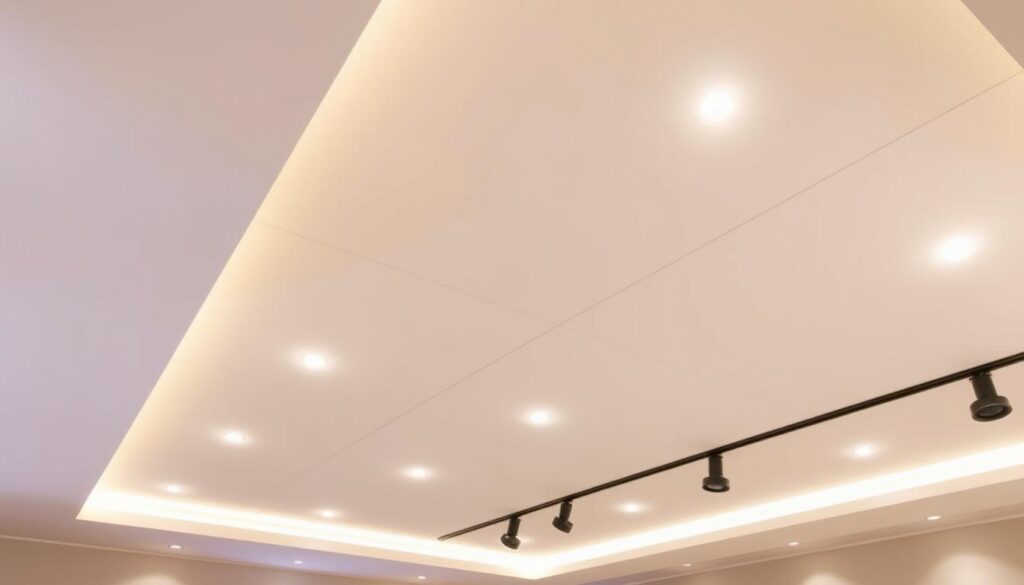
Lighting can turn a basement into a bright, useful space. Ideas for basement ceilings often focus on lighting. Modern solutions, like midcentury flush mounts, add style and light. Here’s how to choose and arrange lights for any basement.
Various Styles of Lighting
- Recessed LED Fixtures: These lights are even and save energy with LEDs. Use dimmers for different moods.
- Midcentury Flush Mounts: These sleek, low-profile lights fit tight spaces. They add a midcentury look without being bulky.
- Pendant Lights: Adjustable lights like the Schoolcraft Studio “Hudson” pendant are great above bars or desks. Pick lengths based on your ceiling.
- LED Strip Lighting: Place these lights under cabinets or along edges for a soft glow. Philips Hue strips let you change colors and dim them.
Placing Lights Strategically
Here’s how to get the best results:
- General Lighting: Use recessed or surface-mounted lights (like Juniper & Sage’s “Mason” downlights) to avoid shadows.
- Task Lighting: Place pendants over work areas and LED strips under shelves.
- Accent Lighting: Use spotlights or glow-in-the-dark panels to highlight features, especially under sky illusion ceilings.
- Energy Efficiency: Choose LEDs like Cree or Philips for less heat and lower energy costs.
| Light Type | Best For |
|---|---|
| Surface-Mounted Lights | Low ceilings (8ft or lower) |
| Pendant Fixtures | High ceilings (10ft+) |
| LED Strips | Entertainment zones or accent walls |
10. Acoustic Panels: Reducing Noise
Basement ceilings often struggle with noise transfer and echoes. Basement ceiling insulation tips like acoustic panels address these issues. They offer practical modern basement ceiling solutions. These materials absorb sound waves, making the space quieter and more functional.
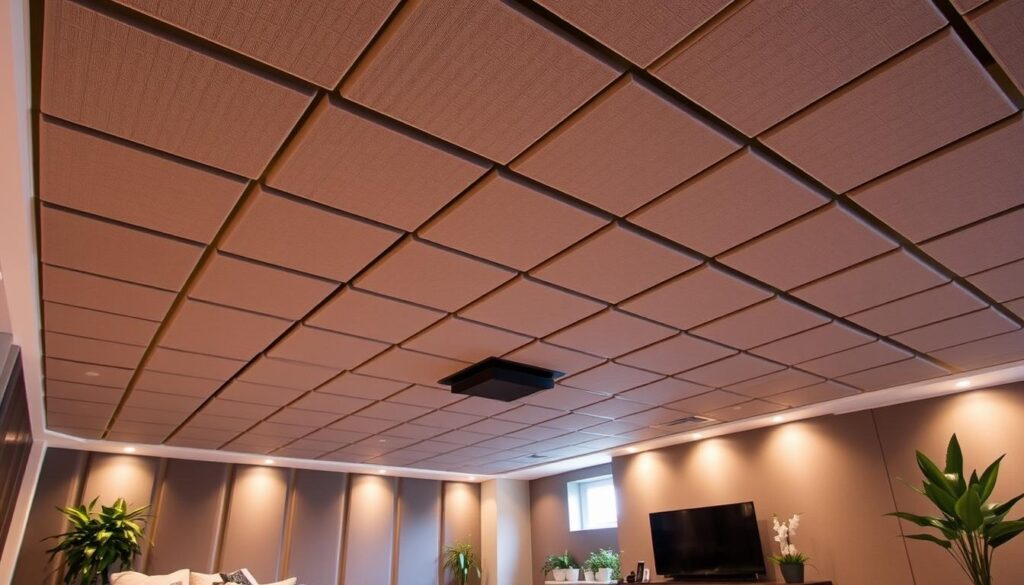
Acoustic panels improve comfort by reducing noise from upstairs activity and lowering basement echoes. Here’s how they work:
Benefits of Soundproofing
- Reduce reverberation and echo for clearer conversations or media playback
- Prevent noise from bass systems or footsteps from disrupting upper floors
- Enhance privacy in home theaters or home offices
Best Materials for Panels
| Material | Features | Best For |
|---|---|---|
| Sonopan | Recycled wood, lightweight, absorbs wide frequencies | Home theaters, music rooms |
| Acoustic Tiles | Suspended designs for rental units or offices | Home offices, rental spaces |
| Mass Loaded Vinyl (MLV) | Blocks sound waves with dense material | Between floors or walls |
| Wood Wool Panels | Eco-friendly, colorful finishes | Modern decor styles |
Using these materials with insulation tips like adding Green Glue between drywall layers boosts results. Choose panels that fit your design while targeting specific sounds. This could be impact noise from above or airborne noise from speakers.
11. Unique Ceiling Decorations to Consider
Make your basement ceiling stand out with creative basement ceiling designs. These ideas blend beauty with function. You can add molding accents or useful fixtures. Try DIY basement ceiling projects for a personal touch without big changes.
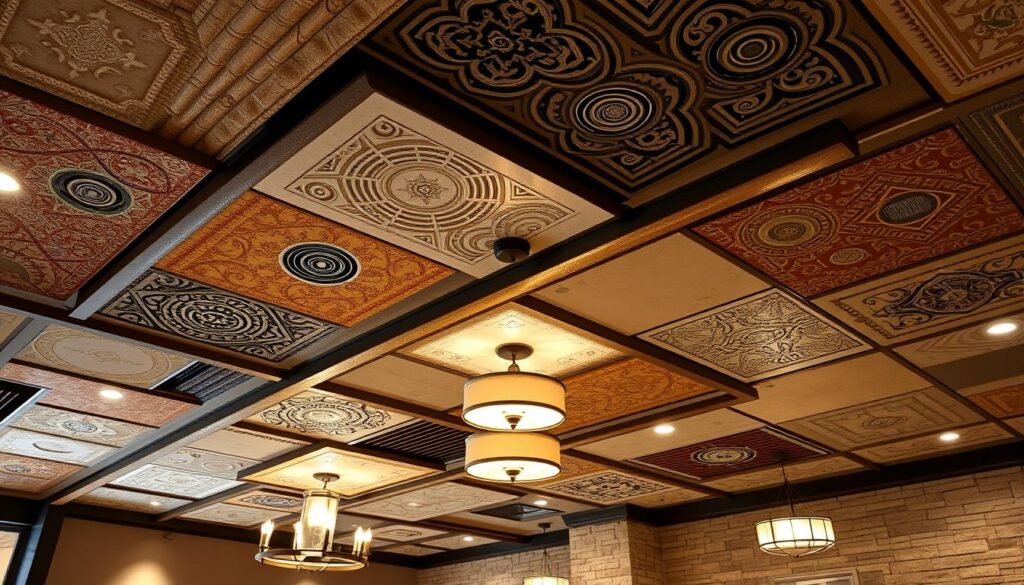
“A well-designed ceiling can transform a room’s energy—start by thinking beyond the ordinary.” — Interior Design Quarterly
Decorative Molding and Trim
Bring architectural charm with coffered patterns or crown molding. WOODHAVEN wood-look planks offer both rustic and modern styles. TINLOOK paintable tiles match any color scheme. Here are some ideas:
- Install deep coffered ceilings with EASY ELEGANCE panels for a structured look.
- Add medallions or crown molding scaled to lower basement heights.
- Use beadboard planks to visually raise low ceilings.
Ceiling Pot Racks for Functionality
Style meets function with shelves or greenery. A DIY basement ceiling project could involve:
- Pot racks in kitchenettes or bars—store cookware or wine glasses overhead.
- Hang faux plants from a custom “planter” for a lush, low-maintenance accent.
- Try MEtallaire panels for metallic accents near wet bars or lounges.
For bold statements, cover walls and ceilings in Jerusalem stone for a unified look. Even small touches like string lights or tin tiles add instant charm. Let your ceiling be part of the adventure!
12. Practical Tips for Basement Ceiling Maintenance
Keeping your basement ceiling in top shape is key. It ensures your space looks good and works well. Whether you’ve chosen exposed beams, acoustic panels, or drop tiles, regular care is crucial. It helps avoid problems like mold or damage to the structure.
Regular Inspection Guidelines
Check your ceiling every three months for signs of water, cracks, or sagging. Use basement ceiling insulation tips to avoid moisture. Clean surfaces carefully—mild soap for painted areas, soft brushes for tin tiles.
For materials like cork or acoustic panels, use a damp cloth for spot-cleaning. If you have drop ceilings, lift tiles once a year to check for dampness or pests.
When to Seek Professional Help
Signs like sagging wood, mold, or electrical hazards mean it’s time for a professional. Structural problems like warped beams or water damage need expert help. For instance, fixing exposed beams might require a contractor.
Costs vary: DIY drop ceilings are $2-$3/sq. ft., while professional installation of wood paneling is more. Always choose safety over DIY for electrical work or major repairs. Low-cost options like painted surfaces or drop tiles make care easier while still looking good.
FAQ
What are some affordable basement ceiling options?
You can choose from painted beams, drop ceilings, and wood paneling. These options are easy on the wallet.
How can I make a low basement ceiling look higher?
Use vertical stripes in paint to make ceilings seem taller. Install lights at different heights. Keep colors light to brighten the space.
What are some stylish basement ceiling decor ideas?
Try decorative molding, coffered ceilings, or hanging plants. These add style and serve a purpose.
How do I insulate my basement ceiling?
Use rigid foam boards or fiberglass batts. Make sure they’re moisture-resistant to fight humidity.
What modern basement ceiling solutions are available?
Go for drop ceilings with panels, bold painted ceilings, or exposed beams. These give a modern look.
Can I use wood paneling for my basement ceiling?
Yes, wood paneling adds warmth. Just pick moisture-resistant wood for basements.
What lighting fixtures work best in a basement?
Recessed can lights, flush mounts, and pendant lights are good choices. They suit different ceiling heights.
What are some unique ways to decorate a basement ceiling?
Use tin ceiling tiles for a vintage look. Add moldings or artwork. These make your ceiling stand out.
How do I maintain my basement ceiling decorations?
Check for moisture and keep finishes in good shape. Light cleaning helps keep decorations looking new.
What materials are recommended for soundproofing my basement ceiling?
Use acoustic panels, foam tiles, and soundproof insulation. They cut down on noise and make your basement cozy.


